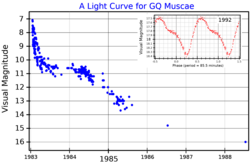 A visual band light curve for GQ Muscae. The main plot shows the decline from the 1983 eruption, plotted with data from the AAVSO, Whitelock et al. and Liller. The inset plot (adapted from Narloch et al.) shows the post-eruption variability seen in 1992. | |
| Observation data Epoch J2000 Equinox J2000 | |
|---|---|
| Constellation | Musca |
| Right ascension | 11 52 02.4285 |
| Declination | −67° 12′ 20.9911″ |
| Apparent magnitude (V) | 7.2 Max. 21 Min. |
| Characteristics | |
| Variable type | Nova |
| Astrometry | |
| Proper motion (μ) | RA: −5.056±0.451 mas/yr Dec.: 1.193±0.324 mas/yr |
| Parallax (π) | 0.4702 ± 0.2193 mas |
| Distance | 2480+3780 −300 pc |
| Other designations | |
| AAVSO 1147-66, Nova Mus 1983, Gaia DR2 5236081560713688448 | |
| Database references | |
| SIMBAD | data |
GQ Muscae, also known as Nova Muscae 1983 is a nova in the constellation Musca, which was discovered by William Liller at 03:20 UT on 18 January 1983. At the time of its discovery it was a magnitude ≈7.2 object, and it subsequently faded.
GQ Muscae is a binary star system composed of a white dwarf and small star, the donor star, that is about 10% as massive as the Sun. The two orbit each other every 1.4 hours. The white dwarf accumulates material from the donor star until a runaway nuclear thermonuclear reaction erupts, as it did in 1983. GQ Muscae was the first nova from which X-rays were detected.
References
- "Download Data". aavso.org. AAVSO. Retrieved 1 October 2021.
- Whitelock, P. A.; Carter, B. S.; Feast, M. W.; Glass, I. S.; Laney, D.; Menzies, J. W.; Walsh, J.; Williams, P. M. (November 1984). "Infrared and optical observations of Nova Mus 1983". Monthly Notices of the Royal Astronomical Society. 211 (2): 421–432. Bibcode:1984MNRAS.211..421W. doi:10.1093/mnras/211.2.421.
- ^ Liller, William (1990). Cambridge Astronomy Guide. Cambridge, United Kingdom: CUP Archive. p. 105. ISBN 0-521-39915-7.
- Narloch, W.; Kaluzny, J.; Krzeminski, W.; Pych, W.; Rozyczka, M.; Shectman, S.; Thompson, I. B.; Tomov, T. (January 2014). "New Observations of the Old Magnetic Nova GQ Muscae". Baltic Astronomy. 23: 1–7. arXiv:1401.7177. Bibcode:2014BaltA..23....1N. doi:10.1515/astro-2017-0168. S2CID 119291924. Retrieved 30 January 2022.
- ^ Brown, A. G. A.; et al. (Gaia collaboration) (August 2018). "Gaia Data Release 2: Summary of the contents and survey properties". Astronomy & Astrophysics. 616. A1. arXiv:1804.09365. Bibcode:2018A&A...616A...1G. doi:10.1051/0004-6361/201833051. Gaia DR2 record for this source at VizieR.
- ^ Schaefer, Bradley E. (2018). "The distances to Novae as seen by Gaia". Monthly Notices of the Royal Astronomical Society. 481 (3): 3033–3051. arXiv:1809.00180. Bibcode:2018MNRAS.481.3033S. doi:10.1093/mnras/sty2388. S2CID 118925493.
- "GQ Muscae". SIMBAD. Centre de données astronomiques de Strasbourg. Retrieved 2019-08-19.
- Marsden, Brian G. (20 January 1983). "Nova Muscae 1983". International Astronomical Union Circular (3764). Retrieved 30 January 2022.
- ^ Hachisu, Izumi; Kato, Mariko; Cassatella, Angelo (2008). "A Universal Decline Law of Classical Novae. III. GQ Muscae 1983". The Astrophysical Journal. 687 (2): 1236–52. arXiv:0806.4253. Bibcode:2008ApJ...687.1236H. doi:10.1086/591415. S2CID 50476380.
- Duerbeck, H.W. (2009). "New Stars and Telescopes: Nova Research in the Last Four Centuries" (PDF). Astronomische Nachrichten. 330 (6): 568–73. Bibcode:2009AN....330..568D. doi:10.1002/asna.200911218. Archived from the original (PDF) on 2015-09-24. Retrieved 2014-03-09.
| Constellation of Musca | |||||||||||
|---|---|---|---|---|---|---|---|---|---|---|---|
| Stars |
| ||||||||||
| |||||||||||
| |||||||||||
| Nebulae |
| ||||||||||
This variable star–related article is a stub. You can help Misplaced Pages by expanding it. |